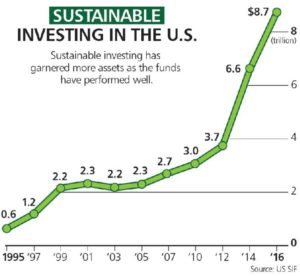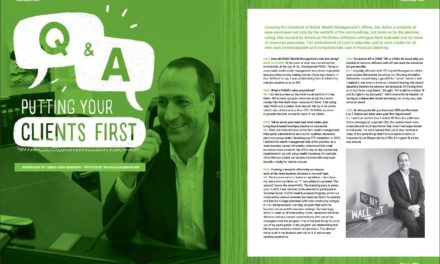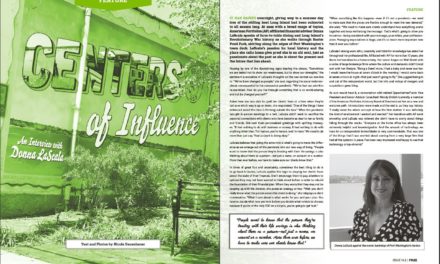
Could ESG Investing Help Earth’s Diminishing Resources?
With major environmental changes and governance (ESG) issues, if we can see beyond the immediate future and the potential impact that external factors place on businesses, then we will be better equipped to make sound decisions and champion ways to continue to yield high returns without affecting our precious resources.
To view the full article please register below:
Could ESG Investing Help Earth’s Diminishing Resources?
Let’s pose a question. How much longer do we have until we exhaust all of Earth’s resources? And, could Environmental, Social and Governance (ESG) investing play a positive role?
Take into consideration the current population, rate of growth and consumer consumption of natural resources. Can we survive without natural resources? Energy, water and oxygen are the three main components of survival. With increasing carbon emission and toxic waste from companies, the depletion of these materials—which are quintessential to our survival—is alarming.
Redundant statements that the core social responsibility of companies is to increase profits and growth is completely unhinged in its essence. The question that should be asked of those who firmly believe this statement is, “Where would your business be located if our land becomes uninhabitable by your ideology and the way you choose to do business?” Rest assured that this question would leave them speechless. There is scant understanding of the important role that our environment plays in the economic development of a country. We need to ask ourselves what each of us can do to carry out our moral responsibility to ensure a prosperous future—not only for ourselves, but for our children and even their grandchildren.
The ESG approach, or ESG data, is integrated into the investment process as a supplement to financial analysis. It becomes a factor when weighing securities for inclusion in a portfolio. Paying keen attention to issues regarding climate change, executive remuneration and employee morale can be as important as the financial metrics used to determine corporate performance.
ESG investments are a fast-growing segment of the financial realm. It’s an opportunity to earn money and make a difference in the world in which we live. Many people opt out of sustainable investing because they feel pressed to choose between wealth and personal value. Furthermore, archaic thought pertaining to the way sustainable investing used to be colors their opinion and, unfortunately, the opportunity to jump on this new “wave” is often missed.
Good ESG factors have been linked to better performance. It is thought that the ESG process is a part of the fundamental analysis that many investors use worldwide. Fundamental analysis studies anything that could potentially harm a security’s value. A company that discloses executive pay, treats its employees well and takes social responsibility into account continuously assists in environmental awareness. It lends itself to improving its processes to ensure that a better society for everyone will and can perform well. ESG, like any other non-Socially Responsible Investing (SRI) funds, identifies long-term opportunities strategically.
Let’s look at the stats.
According to the U.S. SIF, more than $8.10 trillion dollars were classified under management as of the start of 2016. Socially responsible investing now accounts for more than 1 in 5 dollars under professional management in the U.S, a 33 percent increase since 2014. As to returns for 2017, SRI funds averaged a 7.73 percent gain, while non SRI funds averaged a 6.64 percent gain[1]. That’s nearly a 1.09 percent competitive advantage! SRI funds have been proven to outperform non-SRI funds and, as investors realize this, the rapid growth of these funds will increase as time advances. (Refer to the image below to see the increase of money under management for sustainable funds.)

Engaging in the Front Line
A change in corporate culture corresponds to a change in how leaders lead. The engagement process of advocating and exercising shareholder rights is a way that change is brought to the operation practices of businesses on multiple levels. It focuses on long-term outcomes and embraces the idea of being proactive. Furthermore, it inculcates the roots of being an investor.
Recurrently, the financial industry is deemed distrustful and fraudulent. To regain credence is an essential part of engagement, as it opens a gateway to clarity and understanding the customs of a company.
Quite often we turn a blind eye to the issues we face today. The level of damage humans create is beyond comprehension. We are so profoundly blinded that we train ourselves to believe that in order to create a luxurious lifestyle we must do whatever it takes to stay on top. In the process, economic inequality and environmental harm—such as deforestation, pollution and the destruction of major ecosystems—occur because of our collective footprint.
In essence, ESG investing is the distinction between investors who are able to see the big picture. I strongly believe that these are the type of investors we need today. With major environmental changes and governance issues, if we can see beyond the immediate future and the potential impact that external factors place on businesses, then we will be better equipped to make sound decisions and champion ways to continue to yield high returns without affecting our precious resources.
The engagement process allows an individual to not only invest without compromising their personal values, but to invest with a purpose. Whether that purpose is the gap in women’s pay or the lack of diversity on the board, we can play an active role by exercising the shareholders’ right to bring positive change to the way our companies handle cultural issues and their governing bodies. Active engagement allows companies to be conscious of their actions and the potential consequences, and is a powerful way that an individual can make a positive change in our world. Let this change begin with you.
Fighting the Fight for Change
A vast number of people have made a living out of denying climate change; often they will state, “I’m not a climate scientist, but …” before launching into a series of talking points whereby to confuse their audience. Too frequently, the discussion of climate change is instated as a hoax with insufficient theories provided in lieu of sufficient facts.
It stands to reason that what scientists have predicted would logically result as evidence of climate change on a global scale is coming to light and increasing on a significant level, (e.g., melting glaciers, heat waves, sea level changes).2
The argument that stands to “climate deniers” is, if humans aren’t responsible for climate change, then who is to blame? Why are we experiencing spikes in temperature, why are sea levels rising and why are natural disasters occurring on a more frequent basis?
A stereotypical answer would be that climate change is natural. While that is most assuredly true, the process and the speed at which it is happening is moving in the wrong direction and at a reckless rate of speed. Furthermore, if nothing is done, it will continue to accelerate.
Extreme weather, which is made remarkably worse by climate change—not to mention the health impacts of burning fossil fuels—has cost the U.S economy at least $240 billion a year over the past 10 years, excluding the hurricanes and wildfires in 2017, according to National Geographic. “The economic losses are estimated to top $300 billion,” according to a new report.3
We continue to deduce that our world is completely fine and that it will eventually adapt to changes and the pace of growth. Without considering external factors, we see merely a sliver of the overall image. Stop to think about the harm that we place on the environment, and everything and everyone that inhabits it; then imagine what life will be like in 50 or 100 years’ time. We are so fixated on our old habits and, unfortunately, we simply cannot continue to tread in the footsteps of our predecessors.
It’s time for a change in the way we think. We are no longer living in the 18th century. While many believe that climate change is too expensive to warrant taking action, the damage and the cost of waiting will exponentially increase to more dollars. Action needs to be taken now. After all, if you don’t initiate change, who will?
Sources:
1 Benjamin, Jeff. “ESG INVESTING (FINALLY) GETS A LITTLE RESPECT.” ESG INVESTING (FINALLY) GETS A LITTLE RESPECT, 12 Feb. 2018, pp. 8–9.
2 “Sources of Greenhouse Gas Emissions.” EPA, Environmental Protection Agency, 14 Apr. 2017, http://epa.gov/ghgemissions/sources-greenhouse-gas-emissions.
3 “Hidden Costs of Climate Change Running Hundreds of Billions a Year.” National Geographic, National Geographic Society, 28 Sept. 2017, http://news.nationalgeographic.com/2017/09/climate-change-costs-us-economy-billions-report/.
See referenced disclosure (2) (3) and (4) athttps://blog-dev.americanportfolios.com/disclosures/












